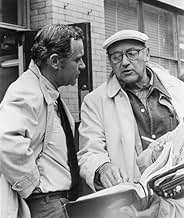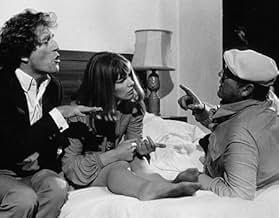Melvin Frank(1913-1988)
- Writer
- Producer
- Director
Melvin Frank was half of a famous screenwriting partnership. The other
half of the collaborative effort was
Norman Panama. The two men became close
friends while attending the University of Chicago. Frank had initially
pursued a degree in engineering, but was persuaded by Panama to switch
to English instead. In 1938 he and Panama moved to Hollywood and
embarked on a career writing radio scripts and gags for
Bob Hope and
Milton Berle. Specializing in light comedy,
they came up with the original story line for Hope's
My Favorite Blonde (1942).
This opened the door for a joint screenwriting contract with Paramount
(1941-46), their prolific work together culminating in an Oscar
nomination for the popular Bob
Hope-Bing Crosby vehicle,
Road to Utopia (1945).
Continuing their run of witty comedies, Frank and Panama next wrote and produced the Cary Grant-Myrna Loy box-office hit Mr. Blandings Builds His Dream House (1948), adapted from a satirical novel by Eric Hodgins (about a couple whose dream of home ownership turns into a nightmare). From then on Frank and Panama alternated as directors and producers, first at MGM (1950-52), then at Paramount (1954-59). Of some ten top-grossing collaborations, their most rewarding effort was the highly entertaining medieval adventure spoof, The Court Jester (1955), starring Danny Kaye, lavishly filmed in VistaVision and Technicolor. They also turned out an award-winning Broadway play, "Li'l Abner", based on a comic strip by Al Capp. It premiered in November 1956 and ran for 653 performances over 87 weeks, before closing in July 1958. Frank and Panama brought it to the screen (Li'l Abner (1959)) the following year.
The successful partnership came to an end with the final installment in the Hope-Crosby "road pictures", The Road to Hong Kong (1962). Subsequently, Frank and Panama--cordially--went their separate ways, Frank becoming a solo director and (from 1965) producer, but continuing to write comedy scripts in conjunction with others. In retrospect, his career over the next two decades was by far the more productive of the two, encompassing as producer/director the bittersweet adaptation of a play by Neil Simon, The Prisoner of Second Avenue (1975); and as producer/director/writer of the popular sex comedy A Touch of Class (1973), nominated for an Academy Award as Best Picture.
Continuing their run of witty comedies, Frank and Panama next wrote and produced the Cary Grant-Myrna Loy box-office hit Mr. Blandings Builds His Dream House (1948), adapted from a satirical novel by Eric Hodgins (about a couple whose dream of home ownership turns into a nightmare). From then on Frank and Panama alternated as directors and producers, first at MGM (1950-52), then at Paramount (1954-59). Of some ten top-grossing collaborations, their most rewarding effort was the highly entertaining medieval adventure spoof, The Court Jester (1955), starring Danny Kaye, lavishly filmed in VistaVision and Technicolor. They also turned out an award-winning Broadway play, "Li'l Abner", based on a comic strip by Al Capp. It premiered in November 1956 and ran for 653 performances over 87 weeks, before closing in July 1958. Frank and Panama brought it to the screen (Li'l Abner (1959)) the following year.
The successful partnership came to an end with the final installment in the Hope-Crosby "road pictures", The Road to Hong Kong (1962). Subsequently, Frank and Panama--cordially--went their separate ways, Frank becoming a solo director and (from 1965) producer, but continuing to write comedy scripts in conjunction with others. In retrospect, his career over the next two decades was by far the more productive of the two, encompassing as producer/director the bittersweet adaptation of a play by Neil Simon, The Prisoner of Second Avenue (1975); and as producer/director/writer of the popular sex comedy A Touch of Class (1973), nominated for an Academy Award as Best Picture.


























